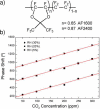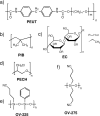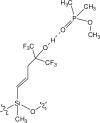Materials and transducers toward selective wireless gas sensing
- PMID: 21899304
- PMCID: PMC3212628
- DOI: 10.1021/cr2000477
Materials and transducers toward selective wireless gas sensing
Figures

GPL: General Population Limit, established by USACHPPM – U.S. Army Center for Health Promotion and Preventative Medicine;
PEL: Permissible Exposure Limit, established by OSHA, Occupational Safety and Health Administration;
TLV-STEL: Threshold Limit Value (Short Term Exposure Limit) and TLV-TWA: Threshold Limit Value (Time Weighted Average), established by ACGIH, American Conference of Governmental Industrial Hygenists;
IDLH: Immediately Dangerous to Life or Health and LOC: Level of Concern, 0.1×IDLH, established by NIOSH, U.S. National Institute for Occupational Safety and Health;
AEGL-1,2,3: Acute Exposure Guideline Levels, established by EPA – U.S. Environmental Protection Agency.









































Similar articles
-
Molecular recognition at the gas-solid interface: a powerful tool for chemical sensing.Chem Soc Rev. 2007 May;36(5):695-706. doi: 10.1039/b516256b. Epub 2007 Jan 10. Chem Soc Rev. 2007. PMID: 17471395 Review.
-
Cognitive radio wireless sensor networks: applications, challenges and research trends.Sensors (Basel). 2013 Aug 22;13(9):11196-228. doi: 10.3390/s130911196. Sensors (Basel). 2013. PMID: 23974152 Free PMC article.
-
Wireless gas detection with a smartphone via rf communication.Proc Natl Acad Sci U S A. 2014 Dec 23;111(51):18162-6. doi: 10.1073/pnas.1415403111. Epub 2014 Dec 8. Proc Natl Acad Sci U S A. 2014. PMID: 25489066 Free PMC article.
-
Upgrading producer gas quality from rubber wood gasification in a radio frequency tar thermocatalytic treatment reactor.Bioresour Technol. 2013 Dec;150:328-37. doi: 10.1016/j.biortech.2013.10.010. Epub 2013 Oct 11. Bioresour Technol. 2013. PMID: 24185417
-
Gas sensors based on mass-sensitive transducers part 1: transducers and receptors-basic understanding.Anal Bioanal Chem. 2019 Mar;411(9):1761-1787. doi: 10.1007/s00216-019-01630-7. Epub 2019 Mar 14. Anal Bioanal Chem. 2019. PMID: 30868191 Review.
Cited by
-
Electrical Properties of Two-Dimensional Materials Used in Gas Sensors.Sensors (Basel). 2019 Mar 14;19(6):1295. doi: 10.3390/s19061295. Sensors (Basel). 2019. PMID: 30875827 Free PMC article. Review.
-
Rapid prototyping of carbon-based chemiresistive gas sensors on paper.Proc Natl Acad Sci U S A. 2013 Aug 27;110(35):E3265-70. doi: 10.1073/pnas.1307251110. Epub 2013 Aug 13. Proc Natl Acad Sci U S A. 2013. PMID: 23942132 Free PMC article.
-
A Passive Radio-Frequency Identification (RFID) Gas Sensor With Self-Correction Against Fluctuations of Ambient Temperature.Sens Actuators B Chem. 2013 Aug 1;185:587-593. doi: 10.1016/j.snb.2013.04.107. Sens Actuators B Chem. 2013. PMID: 23956496 Free PMC article.
-
Investigation towards nanomechanical sensor array for real-time detection of complex gases.Microsyst Nanoeng. 2025 Mar 24;11(1):53. doi: 10.1038/s41378-025-00899-2. Microsyst Nanoeng. 2025. PMID: 40122896 Free PMC article.
-
Highly Sensitive NH3 Wireless Sensor Based on Ag-RGO Composite Operated at Room-temperature.Sci Rep. 2019 Jul 9;9(1):9942. doi: 10.1038/s41598-019-46213-9. Sci Rep. 2019. PMID: 31289292 Free PMC article.
References
-
- Farrar JT, Zworykin VK, Baum J. Science. 1957;126:975. - PubMed
-
- Mackay RS, Jaconson B. Nature. 1957;179:1239. - PubMed
-
- Messer H, Zinevich A, Alpert P. Science. 2006;312:713. - PubMed
-
- Receveur RAM, Lindemans FW, De Rooij NF. J. Micromech. Microeng. 2007;17:R50.
-
- Fleming WJ. IEEE Sensors J. 2008;8:1900.
Publication types
MeSH terms
Substances
Grants and funding
LinkOut - more resources
Full Text Sources
Other Literature Sources

